AMD FX-8320E CPU Review: The Other 95W Vishera
by Ian Cutress on January 13, 2015 10:00 AM ESTProfessional Performance: Windows
Agisoft Photoscan – 2D to 3D Image Manipulation: link
Agisoft Photoscan creates 3D models from 2D images, a process which is very computationally expensive. The algorithm is split into four distinct phases, and different phases of the model reconstruction require either fast memory, fast IPC, more cores, or even OpenCL compute devices to hand. Agisoft supplied us with a special version of the software to script the process, where we take 50 images of a stately home and convert it into a medium quality model. This benchmark typically takes around 15-20 minutes on a high end PC on the CPU alone, with GPUs reducing the time.
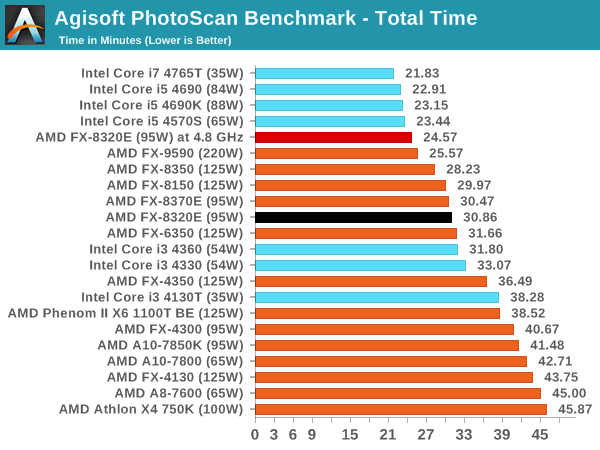
A highly parallel benchmark like Photoscan puts the FX CPUs ahead of our i3 results. When overclocked, it plays just behind the i5 results.
Cinebench R15
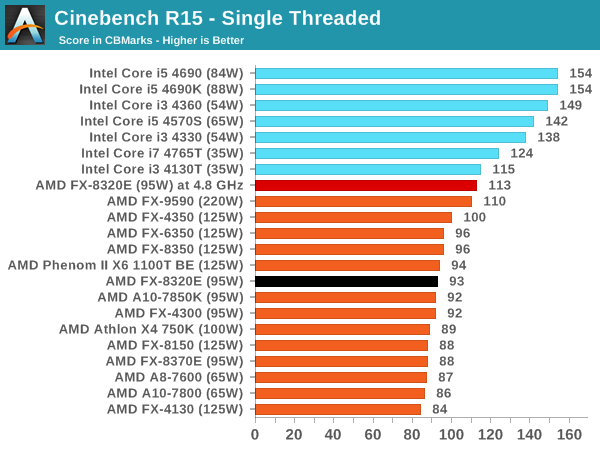
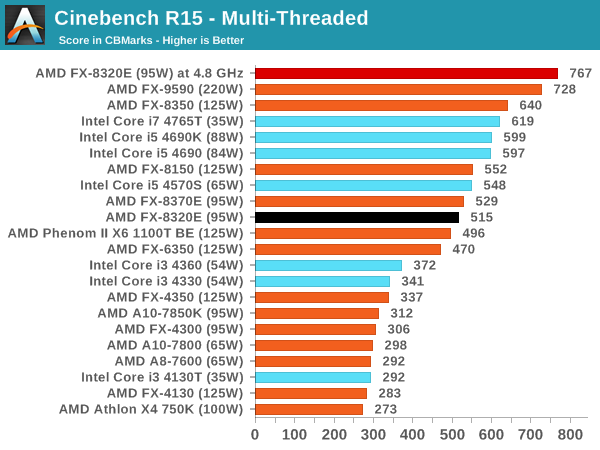
Professional Performance: Linux
Built around several freely available benchmarks for Linux, Linux-Bench is a project spearheaded by Patrick at ServeTheHome to streamline about a dozen of these tests in a single neat package run via a set of three commands using an Ubuntu 14.04 LiveCD. These tests include fluid dynamics used by NASA, ray-tracing, molecular modeling, and a scalable data structure server for web deployments. We run Linux-Bench and have chosen to report a select few of the tests that rely on CPU and DRAM speed.
C-Ray: link
C-Ray is a simple ray-tracing program that focuses almost exclusively on processor performance rather than DRAM access. The test in Linux-Bench renders a heavy complex scene offering a large scalable scenario.
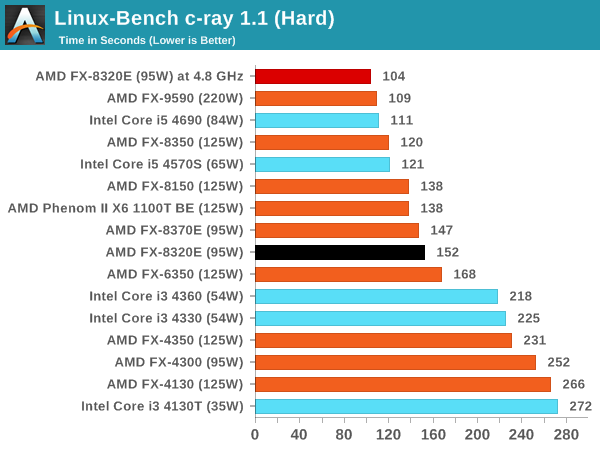
Ahead of the i3, behind the i5 until overclocked seems to be a good motto for this CPU.
NAMD, Scalable Molecular Dynamics: link
Developed by the Theoretical and Computational Biophysics Group at the University of Illinois at Urbana-Champaign, NAMD is a set of parallel molecular dynamics codes for extreme parallelization up to and beyond 200,000 cores. The reference paper detailing NAMD has over 4000 citations, and our testing runs a small simulation where the calculation steps per unit time is the output vector.
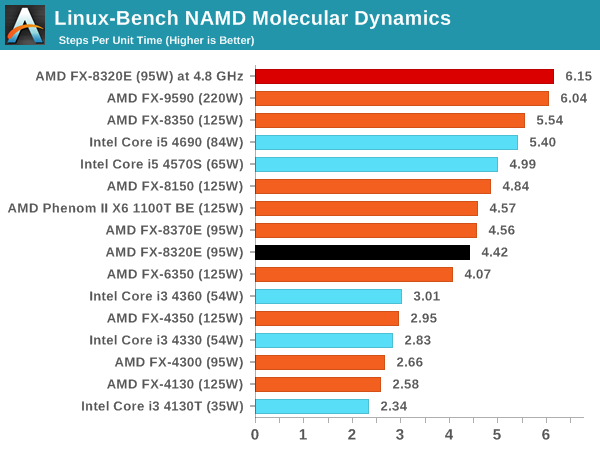
NPB, Fluid Dynamics: link
Aside from LINPACK, there are many other ways to benchmark supercomputers in terms of how effective they are for various types of mathematical processes. The NAS Parallel Benchmarks (NPB) are a set of small programs originally designed for NASA to test their supercomputers in terms of fluid dynamics simulations, useful for airflow reactions and design.
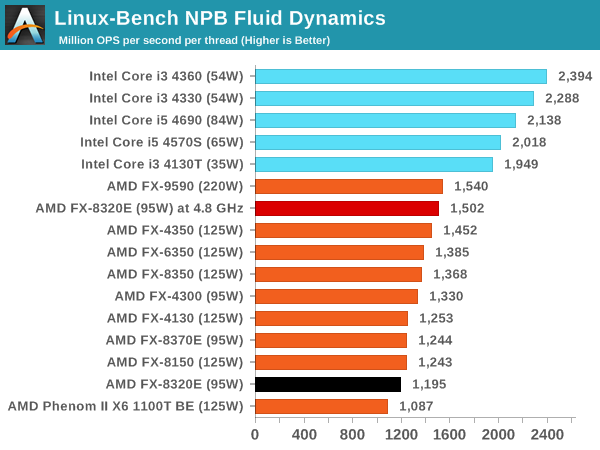
Redis: link
Many of the online applications rely on key-value caches and data structure servers to operate. Redis is an open-source, scalable web technology with a b developer base, but also relies heavily on memory bandwidth as well as CPU performance.
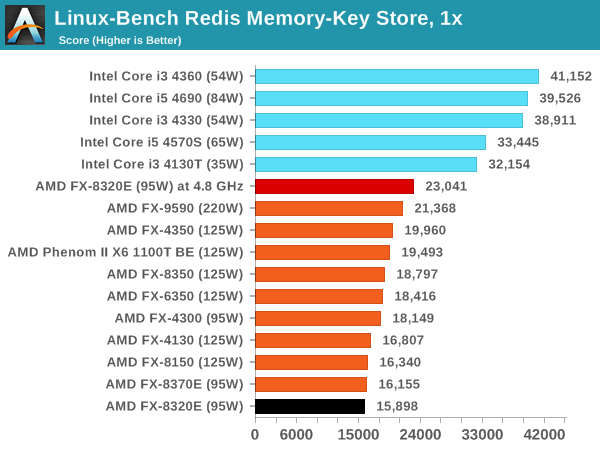
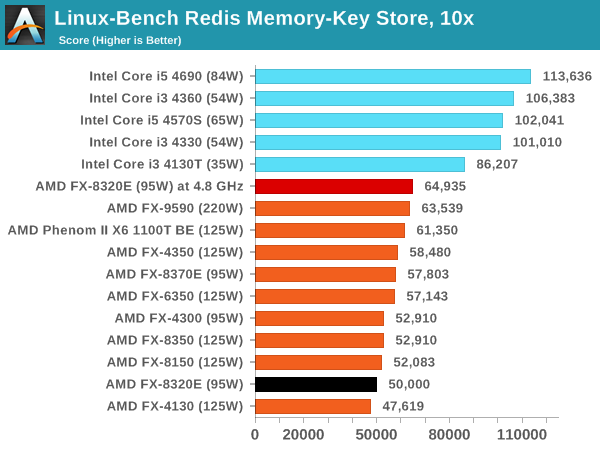
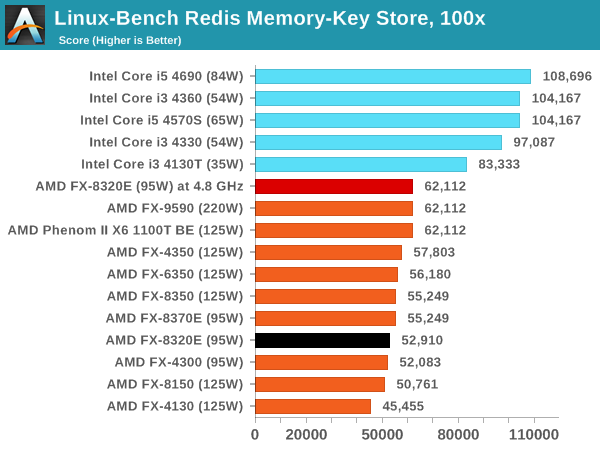
It would seem that one downside to the AMD FX line is the memory access limited scenarios, unless more cores can come into the equation. For redis, that is unfortunately not the case.










92 Comments
View All Comments
cobrax5 - Wednesday, January 14, 2015 - link
I don't think they were saying Intel chipsets work with AMD, they are saying Intel has a greater variety of options from value to performance.I'm actually a fan of AMD keeping their chipset as long as possible as it allows people to update just their old CPU. However, 6 years is a bit long. They really do need to completely revamp it. I guess they are just buying time until skybridge or whatever the ARM/x86 is called...
eanazag - Tuesday, January 13, 2015 - link
Budget chipset is the 970. Real budget is a different AMD CPU like the AM1 socket or APU FM2 sockets.That is just how AMD does it, which is different than Intel. Intel offers 2 sockets. AMD has 3.
hojnikb - Tuesday, January 13, 2015 - link
Not really. 970 is more like a midrange chipset like h97 with intel. You can't find cheap board with 970 like you can with intel.And having a different socket for low/midrange also kills it. Basicly you cant combine cheap board with a fast cpu like you can with intel.
Amd should just stick to one socket. AM4 for apus and normal cpus like fx. That way you have a much bette selection for a given platform and better upgrade path (unlike fm2+).
And ditch am1, nobody really needs socketed option on the lowest end. Just save a bit of money and solder that puppy in there.
abhaxus - Tuesday, January 13, 2015 - link
I picked up an asrock 970 extreme4 on newegg for $69...how much cheaper do you need?hojnikb - Wednesday, January 14, 2015 - link
You can grab H81 mobo for as little as 44.99$. Thats a ~25$ difference, which could be spent elsewere.jabber - Wednesday, January 14, 2015 - link
Does it have serial and parallel ports on the back? ;-)hojnikb - Wednesday, January 14, 2015 - link
It has actually (looking at h81m-d plus).I dont see an issue here.
Cryio - Wednesday, January 14, 2015 - link
Their newest chipset, the FM2+, is for home office, HTPC and low-end gaming. So if you want the latest in MOBO tech from AMD, you need to get either an APU or an Athlon.LarsBars - Tuesday, January 13, 2015 - link
I snagged two FX-8320Es for $119 each to use in two Hyper-V lab machines to leave powered on around the clock. I wanted the extra threads, high memory capacity, and low cost (and, as much as possible for an AMD machine, low power consumption.)They seem to be working out great. I am really glad to see AT still reviewing AMD even though it seems people have given up on them. Thanks, Ian.
Samus - Tuesday, January 13, 2015 - link
Wow, AMD hasn't had a chipset update in 4 years? I wish Intel would take a note from them.